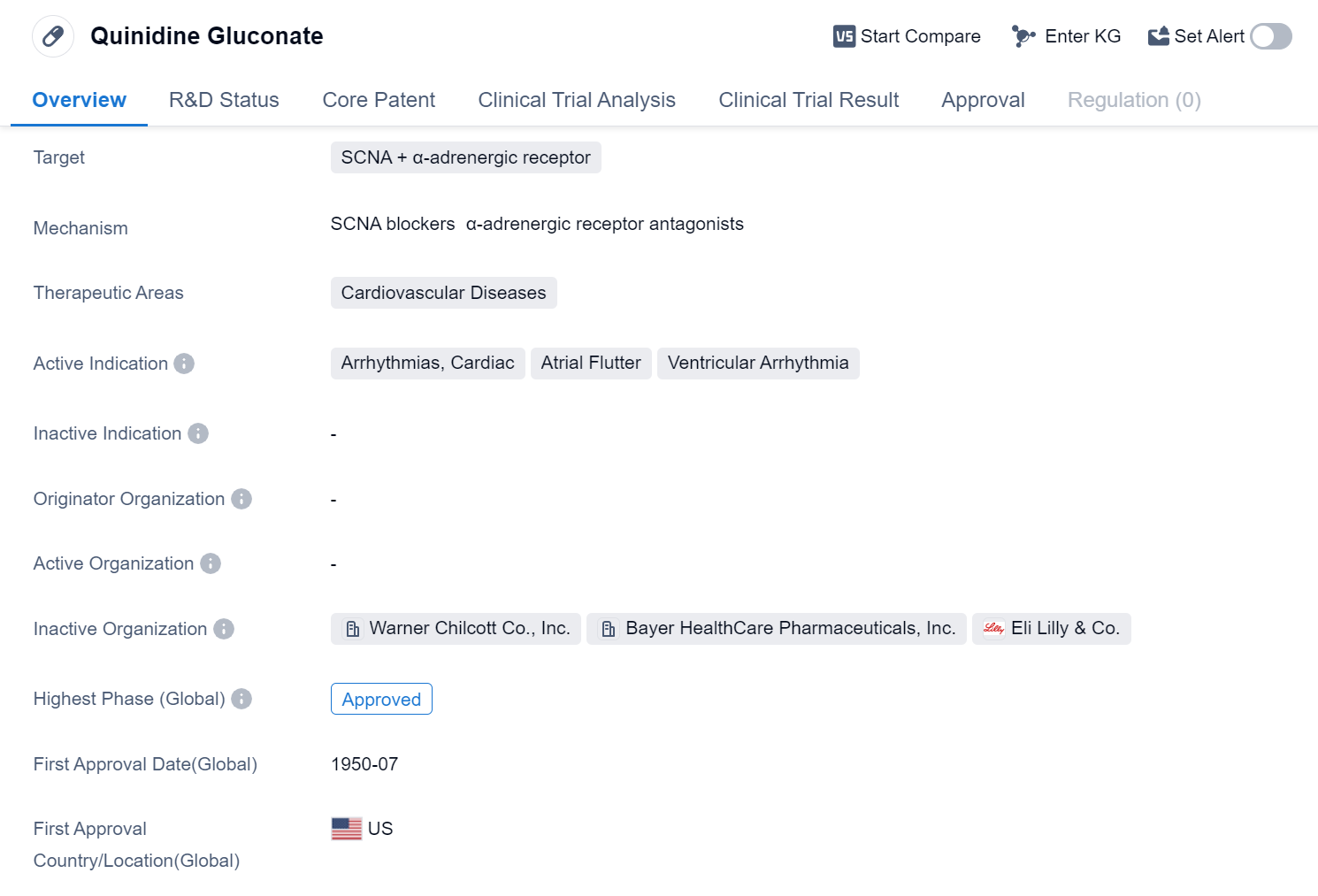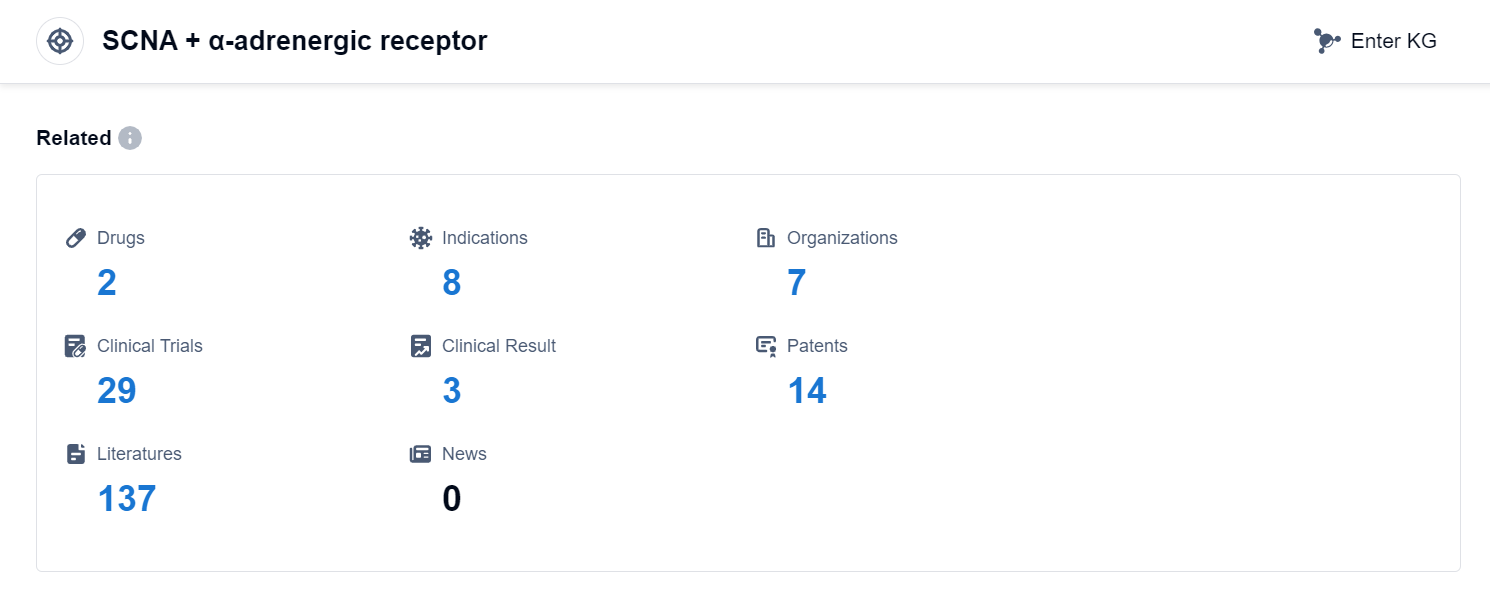Quinidine Gluconate Unveiled: A Detailed Overview of its Revolutionary R&D Breakthroughs
Quinidine Gluconate's R&D Progress
Quinidine Gluconate is a small molecule drug that is primarily used in the treatment of cardiovascular diseases. It targets SCNA and α-adrenergic receptors, making it effective in managing arrhythmias, specifically cardiac arrhythmias such as atrial flutter and ventricular arrhythmia.
The drug has been approved for use since July 1950, with the United States being the first country to grant approval. This indicates that Quinidine Gluconate has a long history of use and has been recognized as safe and effective by regulatory authorities.
Arrhythmias are abnormal heart rhythms that can lead to serious complications if left untreated. Quinidine Gluconate works by blocking certain ion channels in the heart, which helps to stabilize the heart's electrical activity and restore a normal rhythm. By targeting SCNA and α-adrenergic receptors, the drug can effectively regulate the heart's electrical signals and prevent irregular heartbeats.
As a small molecule drug, Quinidine Gluconate is able to penetrate cell membranes and interact with specific targets within the body. This allows for a more targeted and efficient treatment approach compared to larger molecules or other treatment modalities.
The highest R&D phase of Quinidine Gluconate is approved globally. This approval status also suggests that the drug has been widely accepted and used in clinical practice for several decades.
👇Please click on the image below to directly access the latest data (R&D Status | Core Patent | Clinical Trial | Approval status in Global countries) of this drug.
Mechanism of Action for Quinidine Gluconate: SCNA blockers & α-adrenergic receptor antagonists
SCNA blockers are a type of medication that inhibit the activity of sodium channels in the body. Sodium channels play a crucial role in the transmission of electrical signals in nerve cells and muscle cells. By blocking these channels, SCNA blockers can affect the excitability and conduction of nerve impulses.
From a biomedical perspective, SCNA blockers are commonly used in the treatment of various medical conditions such as epilepsy, neuropathic pain, and cardiac arrhythmias. By reducing the activity of sodium channels, these blockers can help regulate abnormal electrical activity in the brain or heart.
α-adrenergic receptor antagonists, on the other hand, are a class of drugs that block the action of α-adrenergic receptors. These receptors are found in various tissues and play a role in regulating blood pressure, smooth muscle contraction, and other physiological processes.
In the context of biomedical applications, α-adrenergic receptor antagonists are often used to treat conditions such as hypertension (high blood pressure) and benign prostatic hyperplasia (enlarged prostate). By blocking the α-adrenergic receptors, these antagonists can relax smooth muscle, leading to vasodilation and decreased blood pressure.
Therefore, the term "SCNA blockers α-adrenergic receptor antagonists" refers to a combination of drugs that simultaneously block sodium channels and α-adrenergic receptors. This combination therapy may be used in certain clinical situations where both sodium channel inhibition and α-adrenergic receptor blockade are desired to achieve therapeutic effects.
Drug Target R&D Trends for Quinidine Gluconate
According to Patsnap Synapse, as of 10 Sep 2023, there are a total of 2 SCNA + α-adrenergic receptor drugs worldwide, from 7 organizations, covering 8 indications, and conducting 29 clinical trials.
Based on the analysis of the provided data, Enanta Pharmaceuticals, Inc. is the leading company in the development of drugs targeting the SCNA + α-adrenergic receptor, with a Phase 1 drug. The approved indications for drugs targeting this receptor include Arrhythmias, Cardiac, Atrial Flutter, and Ventricular Arrhythmia. Small molecule drugs are progressing rapidly under this target. The United States is the most active country in the development of drugs targeting this receptor. Overall, the competitive landscape for the SCNA + α-adrenergic receptor is still in the early stages, with potential for further development and competition in the future.
👇Please click on the picture link below for free registration or log in directly if you have a freemium account, you can browse the latest research progress on drugs, indications, organizations, clinical trials, clinical results, and drug patents related to this target
Conclusion
In summary, Quinidine Gluconate is a small molecule drug that targets SCNA and α-adrenergic receptors to treat cardiovascular diseases, specifically arrhythmias such as atrial flutter and ventricular arrhythmia. It was first approved in the United States in July 1950 and has since gained global approval.






